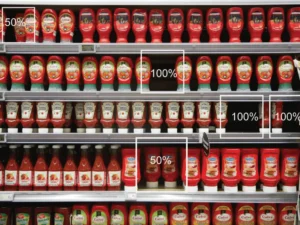With closure of several big box and department store chains, it became all too familiar to call brick and mortar retailing doomed. But despite a paradigm shift towards e-commerce, online retailing is still dwarfed by sales numbers from physical stores.
Even Amazon is experimenting with physical stores. The cashier-less automated and Computer Vision powered store is a glimpse at the future. McKinsey – a business consultancy – has also launched a retail space in US department stores, enabling clients to test new retail technologies.
It is clear that old school brick and mortar retailers have to up their game to compete. Luckily a lot of nascent technologies are enabling retailers to catch up with the digital world. With the help of computer vision and other smart solutions, brick and mortar retail is making a comeback.
Here are the top trends that make physical retailing relevant in today’s consumer landscape.
1. Store visitor analytics
E-commerce retailers enjoy abundance of insights about their customers. Where do they come from? How long do they spend on a particular item? What are they most likely to buy together or next? What is their flow through the website and what should be improved to make their navigation more seamless? These are the ABCs of website analytics and for a long time this was a huge competitive advantage over the physical stores.
However, this is no longer the case. Computer Vision in retail enables same or even greater degree of shopper insights. By analyzing video footage from in-store security cameras, computer vision in retail solutions can measure store visitor count, traffic flow patterns throughout the store, segment visitors by their shopping duration, time of day or even demographic characteristics.
Computer vision in retail solutions are sophisticated enough to recognize the demographic data of customers including age.
In addition, they can analyse shopper emotions, giving an extra edge over the e-commerce analytics.
Did the little black dress from a new collection made the shopper smile? Was she fascinated or excited?
Adding the emotional shopping context can be used for better store layout (perhaps, this dressed placed in the store window makes more people stop and gaze at it with fascination).
So sure, e-commerce retailers can measure the time on site and browsing patterns, but physical stores are much better equipped to understand the human nature of shopping behavior.

2.Cashier-less stores
Queuing up at the cash register adds friction to a seamless shopping experience. 100 years ago a self-service grocery store introduced the first retail revolution by removing the friction of shopkeeper, whom you needed to ask to hand in the items. Now the computer vision in retail technologies allows to get rid of cashier altogether.
Computer vision technologies are employed at self-checkout counters all over the world. With image recognition, they can double check if the bar code you scan matches the product.
Call it ‘computer vision on steroids’ – the same technology can be adopted on a store level. Via security and other carefully placed cameras, it can identify what products a particular shopper has taken and automatically bill them to his account.
In addition, by face recognition technology it can recognize suspicious behavior and shoplifting.
Pioneered by Amazon Go stores, computer vision in retail technology may sound like science fiction, decades away from widespread adoption. However, it is closer to reality than you might think. These computer vision in retail solutions cannot yet power large shopping malls with a plethora of items and a lot of concurrent visitors. Nevertheless, a cashier-less corner store might open on your block in the next 3 to 5 years.
3.Queue management and shop assistant performance
While brick and mortar retailers cannot yet eliminate the cash register, computer vision in retail help to optimize the checkout experience.
None likes to wait in lines. By adopting computer vision for retail solutions, shop managers easily identify the average wait-in-line times, queue size, visitor peak times when cashiers are most over stressed. This information is essential for managing employee shifts.
In addition, the wait time data combined with sales information can help to accurately estimate the losses induced by every minute of wait time.
Furthermore, computer vision in retail can help to objectively measure shop assistant performance. The platform can identify shopper behavior when he requires assistance. It can also identify the in-store shop assistant (usually by the specific employee uniform).
Computer vision in retail can measure how long it took the shop assistant to initiate the contact with the customer, the contact duration, the number of such contacts per day and how many of these contacts have resulted in the purchase of goods.
4.Price matching and restocking
In a more down to earth applications, computer vision solutions in retail is already employed to monitor stock levels of goods in large grocery stores. In physical retailing, every inch of shelving space counts and needs to be utilized at all times.
While retailers can monitor product stock levels via business intelligence systems, computer vision in retail solutions monitor product stock levels on the shelve level, notifying when supplies of milk, for instance, are running low and need to be restocked.
In addition, computer vision in retail technologies can check whether the price labeling is correct for every product. For instance, a discount for product is introduced. Utilizing in-store cameras, the platform can check whether the price labels on the shelve match the price assigned in the stock management system.
The solution not only allows to maximize profits, but also improves overall shopping experience.
Want to better manage queues and improve in-store experience? Get in touch with us.
Not Sure How AI Can Help Your Business? Let’s Talk!

Ugnė Daniūnaitė
Business Development Manager
Book a no-obligation free consultation with our expert.



